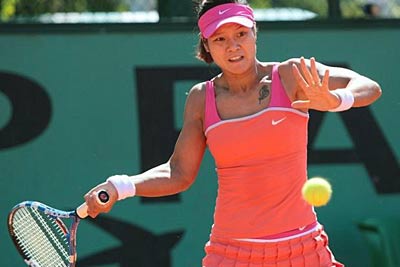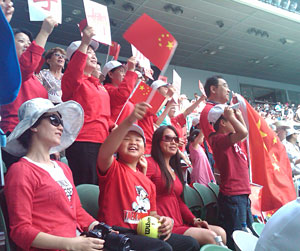|
TennisOne Lessons Li Na: The Great Chinese Hope Paul Fein “Obviously over the years, it’s been America, it’s been Europe. It’s all been very kind of divided between those two continents. It’s nice to kind of see that Asia is starting – and especially China – starting to get recognized in this sport, too.” – Kim Clijsters, paying tribute to Australian Open finalist Li Na, and to other Chinese players, such as 2010 semifinalist Zheng Jie and the team of Yan Zi and Zheng, the 2006 doubles champions.
When her father died, Li learned at age 14 life can be hard and earnest. “After my father died, my mom had to take care of everything. It was tough for her. I learned a lot from her about working hard for everything,” says Li. Li feuded about keeping her prize money with the Chinese Tennis Association, which at first took 60 percent of her earnings, as well as about coaching differences. On her chest a rose tattoo – taboo in China – symbolizes both her independence and her love for her husband, Jiang Shan. Not surprisingly, the assertive Li proposed marriage to him. “When I see myself, I see a strong woman, always fighting,” says Li. That indomitable spirit helped her escape a match point with a brilliant forehand winner and eventually overcome No. 1-ranked Caroline Wozniacki 3-6, 7-5, 6-3 in the Australian Open semifinals. Li displayed the same courage and competitive drive to rebound from a 5-0 deficit to upset No. 3 Kim Clijsters 7-6, 6-3 in the Sydney final two weeks earlier. Now that late-blooming Li, 28, has joined the elite, how far can she go? Let’s analyze her strokes, strategy, physical assets and mental game and find out. Li’s Strokes
“Li Na has a picture-perfect backhand,” says former world No. 1 Lindsay Davenport, who brandished the most devastating backhand in women’s tennis history. “She uses her left wrist more, and that gives her more variety.” Li also boasts excellent backhand footwork, whereby she plants her right foot early in a semi-closed stance. With that solid base, she can drive her racket “through the ball” to generate plenty of power. The Li forehand, which is quite flat and has low net clearance, typically produces more winners than the backhand, but also results in more errors. “Her forehand can break down when things get tight,” notes ESPN analyst Mary Joe Fernandez, a former Australian and French Open finalist. With that in mind, Li should start matches by directing the vast majority of her forehands crosscourt – where the net is lower and the diagonal distance greater – to achieve consistency. The Li serve, while not a weakness, is clearly not a strength. In her 3-6, 6-3, 6-3 Australian Open final loss to Clijsters, a formidable service returner, she won only 52 percent of her first serve points, compared to 66 percent for Clijsters. Hitting only one ace and committing four double faults, she averaged a mediocre 155 km/h (96.3 mph) on first serves and a borderline acceptable 137 km/h (85.1 mph) on second serves. Li’s serving statistics were quite similar in her semifinal upset over Wozniacki with one notable exception. She won 66 percent of her first serve points, which can be attributed mostly to Wozniacki’s less effective service return and overall lack of aggression.
Her fastest first serve of 168 km/h (104.4 mph) suggests Li has the potential to average 100 mph for first serves and 90 mph for second serves, which should be her speed goal for 2011. Li should try to emulate the superb kick serves of Samantha Stosur and Svetlana Kuznetsova. If she added significant topspin and variety to her second serve, she would reduce the double faults and elicit occasional service return errors and weak returns. The Li conventional volley needs more power, though her midcourt swinging volleys proved a big plus in the deciding set against Wozniacki. Interestingly, she outplayed both Wozniacki and Clijsters in the forecourt. Li made an impressive 65 percent of net approaches (20 of 31) against counterpuncher Wozniacki, who won 56 percent (5 of 9) of her net approaches. Li was also more adventurous and effective against Clijsters, as she won 67 percent of net approaches (14 of 21), compared to 54 percent (7 of 13) for Clijsters. However, the Li overhead is definitely a weak link in her forecourt game. Against Clijsters, she lacked the power and placement to put lobs away and seemed able to hit overheads only crosscourt. Nothing can sap a player’s confidence more than the inability to win points outright with overheads, and then to lose the point eventually.
Fitness and Speed The fitness and court coverage of the solidly built, 5’8” (1.73m), 143 lbs. (65 kg) Li stood out against powerful but relatively slow Andrea Petkovic in her convincing 6-2, 6-4 quarterfinal victory. Li also held her own against Wozniacki and Clijsters, among the Tour’s fastest and most agile opponents. “A lot of players have commented about the improvement in her conditioning,” noted ESPN analyst Pam Shriver, a 1980 doubles superstar. “I’ve seen some great agility tonight [against Clijsters] when she’s raced up for drop shots and back for overheads. Her footwork and athleticism are at their peaks now.” Li’s Strategy Li plays high-risk, high-reward tennis. At her best, she can beat anyone. She has defeated No. 1 Wozniacki the last three times they played, Clijsters in two of their last four matches, Venus Williams both times they played (at the 2008 Beijing Olympics and the 2010 Australian Open), Serena Williams only once but pushed her in five other close matches, Vera Zvonareva three times, Maria Sharapova in their last two matches, and Francesca Schiavone at the 2009 U.S. Open. But when her relentless aggression crosses the line and becomes reckless, her unforced errors increase sharply, and she often suffers bad losses to lesser opponents. Last year, for example, she was upset a shocking eight times in the first round by players ranked outside the top 50. Fernandez put it best when she said, “There’s no Plan B with her game. She will continue to be aggressive, no matter what.” One encouraging sign, though, is Li raised the net clearance on her groundstrokes in the Aussie final against high-percentage Clijsters. Besides reducing her errors, that change also gave her groundstrokes more depth. In addition, Li showed nice touch on drop shots, which she should use more often this year. Finally, if I were coaching her, I would tell Li to put a little more topspin on her groundstrokes. Topspin will decrease her errors and make it easier to create sharp angles that force her opponents out of position, either into the alley or outside of it. Li’s Mental Game The pressure to become the first Chinese and Asian to win a Grand Slam singles title didn’t seem to burden Li, aside from some nerves in the first two games when she lost eight straight points. She quickly recovered and won the opening set. As Fernandez pointed out, “She’s always been a dangerous player, but mentally is where she has improved. Now when her play dips, she recovers much faster.”
One statistic, break point conversions, reveals Li’s terrific poise on crucial points at Melbourne. Against 8th-seeded Victoria Azarenka, she converted 83 percent (5 of 6) break points; against Petkovic 63 percent (5 of 8); against Wozniacki 70 percent (7 of 10); and against Clijsters 50 percent (6 of 12). In her first major final, however, Li’s inexperience in big matches betrayed her. Ironically, it was fervent Chinese spectators, trying to help her with unsolicited – and illegal – advice, who unwittingly hurt her. After Clijsters started turning the match around in the second set, Li angrily complained to chair umpire Alison Lang: “Tell the Chinese not to teach me how to play tennis.” She was also upset about well-meaning but zealous fans who shouted “Finish her off!” during points and “Out!” on close line calls. Photographers’ flashes bothered Li, too. As she grew more frustrated and distracted, Clijsters, a veteran in her eighth major final, grew more assured and gave up only one point in her last three service games. Li, who also complained about her fanatical followers during the Beijing Olympics, must learn to focus so intently on the ball and the match that nothing and no one can distract or distress her. Fighting an opponent is a formidable challenge in itself, particularly in a Grand Slam final, without fighting other battles at the same time. Li should study videos of legends Bjorn Borg and Chris Evert, two paragons of calmness and concentration. Li's Future While it’s not likely Li will reach the final at the French Open where the slow clay blunts her power, she certainly has the talent, game and determination to win Wimbledon, where she has reached the quarters twice before, and the U.S. Open. China emerged as the world’s second-largest economy in 2010. And if Li keeps improving, she could emerge as the world’s second-best female tennis player in 2011. Your comments are welcome. Let us know what you think about Paul Fein's article by emailing us here at TennisOne.
Paul Fein Paul Fein has received more than 30 writing awards and authored three books, Tennis Confidential: Today’s Greatest Players, Matches, and Controversies, You Can Quote Me on That: Greatest Tennis Quips, Insights, and Zingers, and Tennis Confidential II: More of Today’s Greatest Players, Matches, and Controversies. Fein is also a USPTA-certified teaching pro and coach with a Pro-1 rating, former director of the Springfield (Mass.) Satellite Tournament, a former top 10-ranked men’s open New England tournament player, and currently a No. 1-ranked Super Senior player in New England. |

